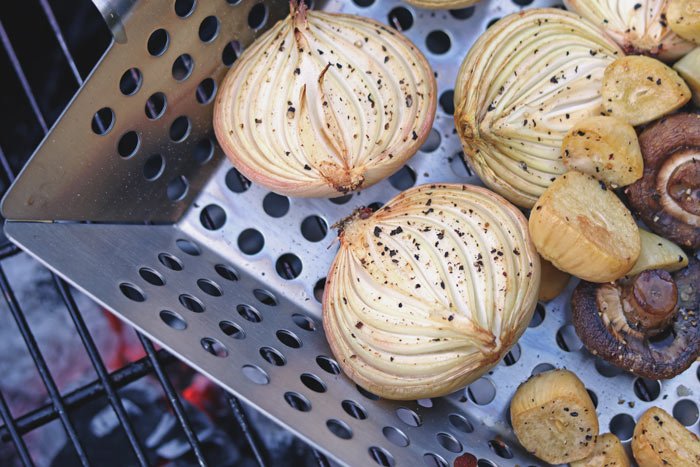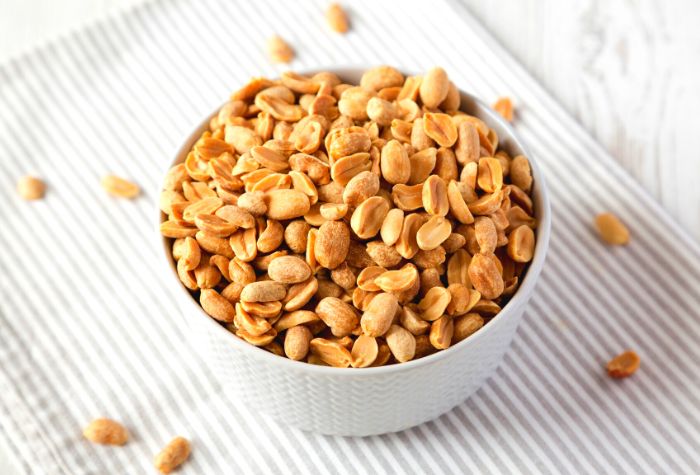Make your own homemade sauerkraut. Crunchy and sour in equal measure, it’s the perfect condiment topping for meat, sandwiches, eggs, and more!
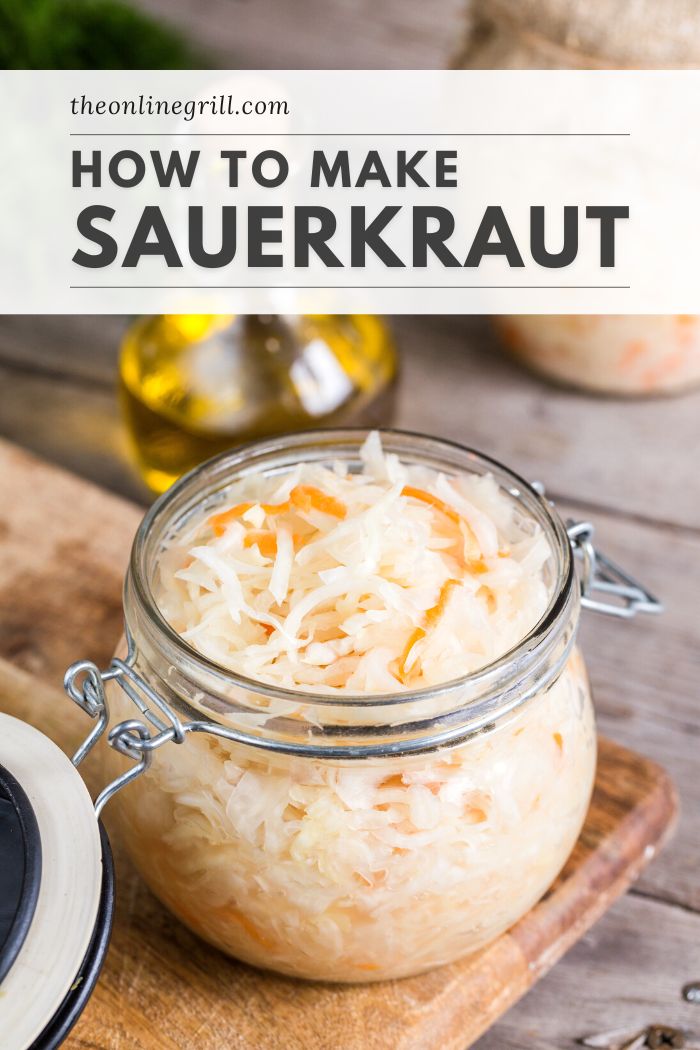
If you enjoy pre-made sauerkraut, then get ready to have your socks blown off. Homemade sauerkraut is a whole new level of flavor. It’s a world apart from store-bought options and will be your new favorite BBQ side dish.
Crunchy and sour in equal measure, it’s unlike anything else. And the good news is that anyone can make it. It’s the perfect pairing with meat, making it great in sandwiches and burgers. There’s a reason why millions of Bavarians enjoy it served with bratwurst sausage.
Made from just cabbage, salt, and water, it couldn’t be easier to make. The only obstacle is time, so be patient. Once fermentation starts, it’ll need at least three weeks to turn into delicious sauerkraut. But we promise you the results will be well with it.
From cabbage shredding to fermenting, discover how to make homemade sauerkraut today.
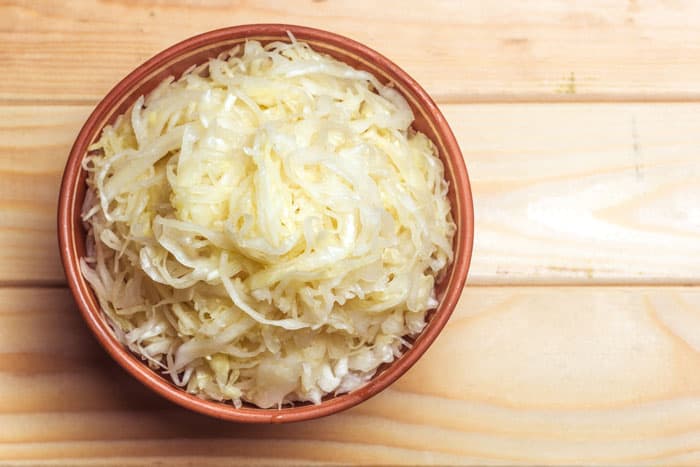
Sauerkraut Explained
Sauerkraut is one of Germany’s best-known dishes, and for good reason. Literally meaning ‘sour cabbage’, the simple side dish is made by fermenting shredded cabbage in water and pickling salt for weeks in order to cultivate the distinct sour-but-crunchy dish we know.
It’s a great entry to fermented foods for newcomers. Featuring one core ingredient and a mason jar, it’s easy to make and is very hands-off once fermentation begins.
While you can make large batches of the stuff in a crockpot, a 1-quart mason jar (like this one on Amazon) is the perfect size to get started with.
Once submerged and sealed in the jar, the cabbage will release its water content and effectively create its own brining solution. After a few days, it’ll start to ferment and slowly form the sauerkraut we know and love.
The essence of our homemade sauerkraut will be just three simple ingredients: Cabbage, salt, and juniper berries. Heck, it doesn’t even need the juniper berries, but I saw it recommended by the AllThingsBBQ YouTube channel, and I haven’t looked back since trying it as added seasoning.
It takes time, but the weeks of fermentation that goes into creating it is what makes the ingredient so special and delicious.
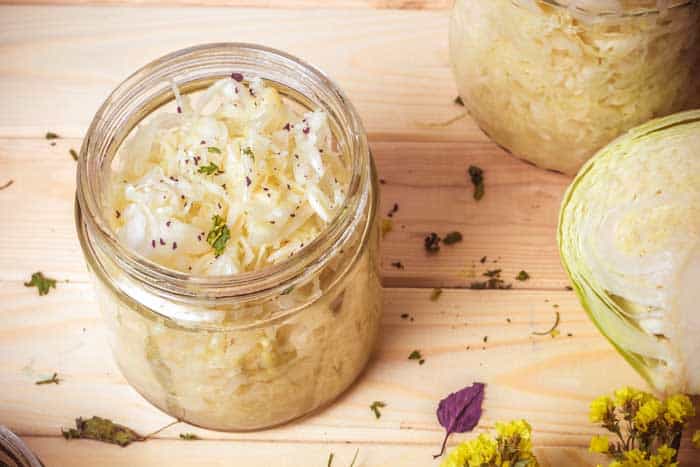
How to Make Sauerkraut
Homemade sauerkraut is the perfect topping for smoked pork, grilled hot dogs, and sandwich filling. It takes a lot of patience, but we promise the results are well worth it! This is how to do it:
- Shred: Quarter and core the cabbage before shredding the leaves into thin pieces
- Crush: Put all the shredded cabbage pieces in a bowl and add salt. Start to crush the cabbage with your hands to break it down, kneading to release water from the leaves.
- Knead: Add juniper berries and continue to knead. Leave to rest for 20 minutes before kneading again. Repeat this process until you see standing water in the bowl.
- Ferment: Transfer the cabbage to a mason jar and cover it with more salt-water solution (full details in the recipe card below). Submerge the cabbage fully in the solution before sealing the jar and leave to ferment at room temperature for three weeks. Don’t forget to degas the jar every few days by loosening the lid slightly before tightening again.
Topping Ideas
These topping ingredients can help add visual appeal, taste, texture, or even nutritional value to your homemade sauerkraut. Whether it’s juniper berries for added color and flavor or ginger for a little kick of heat. Whichever you choose, try to keep a 3:1 ratio with the cabbage to stop you from going overboard!
Juniper Berries
Juniper berries are a classic addition to sauerkraut, and it’s easy to see why. These little purple berries pack in a powerful punch that cut through the sour flavor of cabbage beautifully.
Ginger
Ginger has an uncanny ability to warm anything it’s in, and is a great addition to any winter dish. There’s a good reason why it’s added to almost any home remedy for the common cold. In sauerkraut, grated ginger adds a deep and mild layer of heat, and will be perfect served alongside pork in particular.
Beets
If you want a bit of sweetness in your sauerkraut, adding some grated beet to the mix can go a long way. They’re a great way to balance out the saltiness of the cabbage.
They have a vibrant color and an earthy, sweet flavor. This complements the acidity of the sauerkraut. Beets already have sugar in them, and as such, they need to be used in moderation, or they can skew the fermentation process.
Other
You can use lemon peels to add a zestiness, as well as a dense and firm texture. You can also add caraway seeds. Also, think about adding fennel bulbs or stalks as well. Simply slice them thinly or grate them. You can blend them with apples to add acidity and sweetness.
Why Did My Homemade Sauerkraut Mold?
There are a couple of reasons why mold may form on sauerkraut. One of those is that the pH level won’t be dropping the way it’s meant to. Also, it may have mold because it has been contaminated. Sauerkraut has bacteria in it, which helps it ferment. But when this is overdone, and there are more bacteria than necessary, then your sauerkraut is most likely to mold.
When there is too much air inside the container where you are making your sauerkraut, then there is a possibility that mold will form alongside yeast. You do not want the yeast to overgrow.
Also, mold will form when there’s not enough salt that has been used. Mold may also develop if it is left exposed to high temperatures.
What Kind of Salt Do You Use?
Salt is a great ingredient to help slow down the fermentation process. There are different types of salt. The first being processed salt. These include table salt, kosher salt, and common iodized salt. These salt types also have various additives in them, and they are not a good idea in using to ferment food like sauerkraut.
The additives can inhibit the natural progression of bacteria needed for fermentation. The only type of processed salt that you could consider using is picking-salt, which is granulated and does not have anti-caking ingredients such as iodine.
The other type of salt that you can use is a wet mineral salt, such as grey salt. It has naturally occurring minerals as well as high moisture content. The downside with this salt is that it could contain harmful toxins from the water, thanks to all the pollution.
The best type of salt to use for making sauerkraut should be rich in minerals. Some examples are Himalayan pink salt, and It should also be dry. Himalayan salt is in its natural state and crystalized more than 200 million years ago. It has a high mineral profile that helps ferment food well.
A word of warning though: Adding too much salt can be a common mistake. But this does not mean that you need to throw out your sauerkraut. You can rinse off the excess salt and get the levels that you need. Simply add 1 to 2 teaspoons of purified water to the cabbage with too much salt. Mix it in and taste to check on it. If it’s still not the right amount, then you can keep repeating the process till the taste hits the right spot.
Bavarian Sauerkraut vs. Regular Sauerkraut
These two types of sauerkraut differ in that Bavarian sauerkraut is milder and also sweeter than regular sauerkraut. When they are raw, there isn’t too much difference. Also, Bavarian sauerkraut is sweetened by caraway seeds. Sauerkraut recipes may also differ in the stock used.
How to Grill Sauerkraut
To grill sauerkraut, make sure that it is properly strained first. It will usually have a lot of juice in it, and so you will need to make sure that it is dry before you try to grill it. Then make sure that you season it with just enough salt and olive oil, the way that you see fit, and wrap it up in foil. The foil will help in the grilling. The foil’s point is to create a parcel to hold the sauerkraut in as you put it on the grill.
How Long Should I Ferment Sauerkraut?
While recipes may differ, the recommended time for fermenting sauerkraut is a minimum of 20 days. The flavors will have fully formed, and the acidity levels will have reached the optimum levels. After this time, the sugars in the cabbage will also be dissolved.
Some of the most important bacteria are formed within the first three days. Between the third day and the 16th day, the process of the formation of lactic acid begins. This is how the sauerkraut gets its preservative nature. Lactic acid will also help support digestion and also stops harmful bacteria from growing.
Quick Tips
- Pay attention to the seasons. While we’ve given three weeks as a general guide to the fermentation time, sauerkraut will ferment quicker in the warm summer and slower in the cold winter.

Homemade Sauerkraut
Equipment
- plastic wrap
Ingredients
- 3 lb head of cabbage
- 1 oz kosher salt
- 2 tsp juniper berries
Brine
- 2 cups water
- 2 tsp kosher salt
Instructions
- Remove some of the outer leaves of the cabbage and put to one side (we’ll be using these later). Cut the entire cabbage head into quarters, and then remove what’s left of the core from each quarter.
- Shred the cabbage quarters with a large knife into thin pieces. Transfer shredded cabbage to a large bowl and toss lightly. Add kosher salt.
- With your hands, start to crush cabbage in order to work in the salt and break down the cabbage pieces. Knead it until you start to see water being released from the crushed cabbage.
- Add juniper berries, combining evenly
- Cover bowl with plastic wrap and leave for 20 minutes. Repeat kneading process again, and leave for a further 20 minutes. Repeat the process until you see standing water in the bowl, about 3 hours.
- When the cabbage is ready for fermentation, you’ll notice that it looks wet and has lost some of the bright green color that it has when fresh. When you pick up a handful of it and squeeze it, a good amount of liquid should drip out. Crucially, you should see liquid standing at the bottom of the bowl.
- For the fermentation, we need to add an extra salt-water solution. To make this, combine just 2 cups of water with 2 tsp of kosher salt. Stir to dissolve.
- Transfer cabbage to a mason jar, and pour salt-water solution on top. If the cabbage isn’t completely covered, you will need to make more solution. Make sure that you keep the 1 cup of water-to-1 tsp kosher salt ratio.
- Press the cabbage so that it’s submerged in the solution. Try to allow about half an inch of solution on top to ensure that the cabbage won’t be exposed to the air at all.
- Reach for the cabbage leaves we put aside earlier. Place these in the mason jar on top of the cabbage, acting as a barrier weight to keep the cabbage shreds submerged in the solution.
- Once the cabbage is fully submerged, screw the lid of the jar on. Store at room temperature (not in your refrigerator) out of the way of direct sunlight. After a couple of days you should see the process start, with pressure building within the jar. When this happens, loosen the lid slightly to let the gas out before tightening it again. Do this every 3-5 days.
- There is no hard and fast rule with how long fermentation can take. Allow at least 3 weeks, and then test to see how it suits your tastes. As long as the cabbage is always submerged and nothing weird has started to develop in the jar, you’re safe to try it.
FAQ
When made in a mason jar, sauerkraut takes at least 3 weeks to make. It starts to ferment after about 3 days, and needs to be degassed every few days to relieve the pressure building up in the jar. Larger volumes of sauerkraut will require more time.
Just like with many other fermented foods, eating sauerkraut is linked to a number of health benefits. It contains a lot of probiotics, which can aid digestion and boost your immune system. Sauerkraut is high in sodium however, so be careful with the quantities that you eat.
Sauerkraut is best known in Germany as an accompaniment to smoked or grilled bratwurst, but is also great in meat-heavy sandwiches and burgers. It’s also great on non-meat foods, like scrambled eggs, avocado, and as a salad dressing.
Yes, it can. Technically, sauerkraut has already fermented. However, there is a point where the bacteria goes beyond an edible point. You will know this has happened by a bad smell, texture, and color as well.
Heating will only kill the probiotics in the sauerkraut if it is above 114˚F (46°C). If you are cooking on low heat, then the chances are high that you will still maintain the good bacteria. As such, it is essential that you only add sauerkraut to your dish when you are almost done cooking so that it doesn’t reach high temperatures.
On a hot summer’s day, with the grill roaring into life, you may be wondering what else goes with your sauerkraut. You can pair it with different types of sausage, including hot dogs. It also goes well with hamburgers and sandwiches. You may also use it as a filling for tacos or add it to a green salad, with some barbecue bits tossed in.








